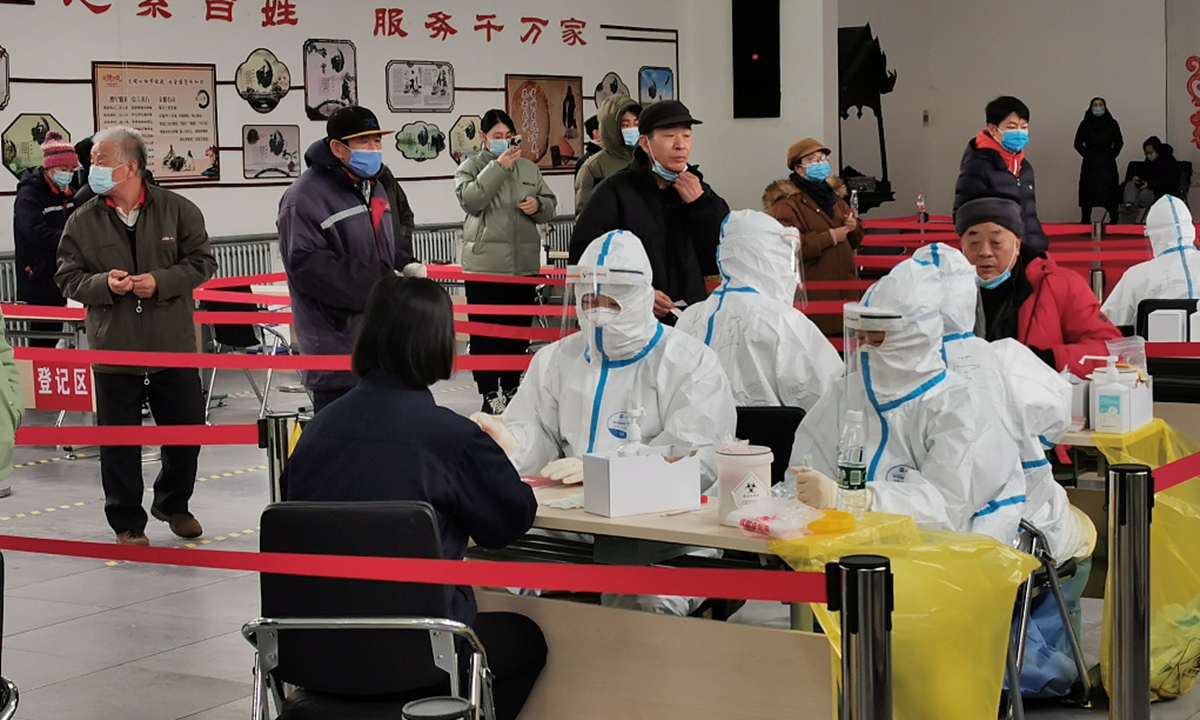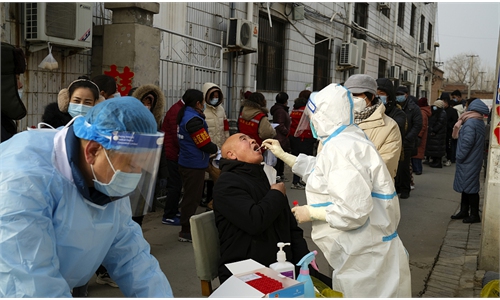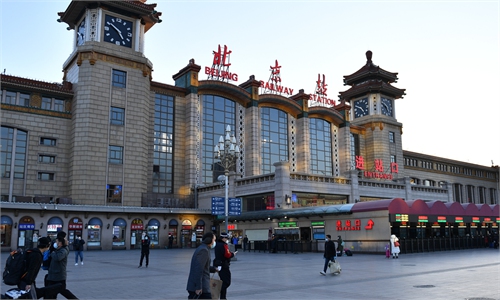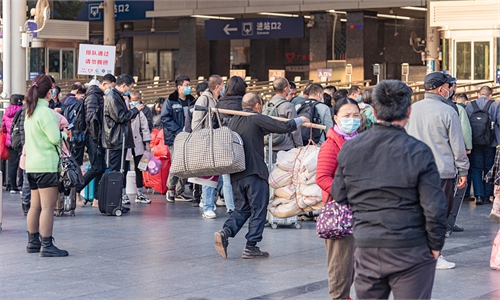Holidays challenge villages' epidemic controls
Local loopholes in viral fight hard to be fixed overnight

Villagers queue up to receive nucleic acid testing at a designated site in Chaoyang district, Beijing on January 14. Photo: VCG
Chinese health authorities released on Wednesday an extra strict guideline especially for people returning to their hometowns in rural areas during the upcoming Spring Festival holidays, stipulating tough measures including a 14-day health monitoring period at home after arrivals. Many wonder, however, if such moves will fix existing local loopholes.
Many observers speculated that the highly complex and strict procedure listed in the guideline itself could dissuade a large part of those from returning to the rural areas in the first place. However, grave challenges would likely remain in local systems, as problems such as weaker nucleic acid testing capabilities and overreacting in terms of management are unlikely to be reversed soon, the Global Times learned.
Since early January, Xia Shiwei, a grass-roots official from Poyang township in East China's Jiangxi Province, has been collecting information of returnees who work in other areas, as he clearly understands their return will make the anti-epidemic mission of the village much harder.
"We require every community to report and register information of people who recently returned from other places, but, inevitably, such a survey could never cover everyone," Xia told the Global Times on Thursday.
In a bid to plug such loopholes amid the grim domestic epidemic situation ahead of the holidays, the National Health Commission said those who return to their villages must undergo nucleic acid tests and have their health monitored at home, which has become a new and heavy assignment for local officials.
Despite the strong contagiousness of COVID-19 virus, many villagers were found to be reluctant to alter their gregarious lifestyles.
"Preventing gatherings remains quite a problem in normal times, let alone when migrant workers return in the holidays. Unless there is a routine patrol of officials, group gatherings and random walks will be seen everywhere," the local official said.
Family reunions are an important part of the Chinese New Year, especially on the first days on the lunar calendar. Family members and relatives will visit each other, play mahjong and have dinner together.
"I wouldn't call it a Spring Festival if there is no gathering and big family dinner," a 70-year-old man in North China's Hebei Province said.
Nong Jieli, a resident in Binyang township of South China's Guangxi Zhuang Autonomous Region, told the Global Times on Thursday that the return of millions of migrant workers will be "like a bomb" for townships, where anti-epidemic work is slackening off. A large number of people from Guangxi work in neighboring Guangdong Province.
Almost half of the locals take off their masks in public and view scanning health QR codes as a formality, as they believe that the epidemic situation in the southern part of China is nothing to worry over compared with northern China, Nong said. "This could be very dangerous if there is an infected patient."
Other key weaknesses for rural areas are the lack of strong nucleic acid testing capability and proper medical quarantine venues, in case a cluster of infections breaks out, according to Yu Shaoxiang, chief research fellow with the Chinese Academy of Social Sciences.
Villages usually see doctors at small clinics that are prone to cause cross-infections due to shortages of testing capacity and designated quarantine places as well as low awareness, Yu said.
Xia told the Global Times that the only venue for Poyang to carry out testing is the county people's hospital.
Authorities' emphasis on epidemic control in rural areas is not meant to be discriminatory, but it is a precaution reflecting loopholes in the local epidemic-control hardware and software, Yu explained to the Global Times.
Villages are the roots of the majority of Chinese people, where their families live from generation to generation. It is traditional Chinese culture that all family members will gather together to celebrate the Chinese New Year. China's rural areas account for more than 94 percent of the country's total land area and more than half of its population comes from villages, reports said.
When so many people return to rural areas, local governance faces huge challenges, Yu noted. The quality of local officials drastically varies, and some overreact and fail to balance the toughness of the viral fight and effective, strict measures, with a humane approach, resulting in "simple and crude" incidents.
Since early stages of the epidemic last year, many cases have emerged, such as tying a villager who refused to wear a mask to a pillar and slapping people for playing mahjong together.
"I believe if the local government is able to publicize anti-epidemic measures properly to villagers, such extreme and absurd incidents can be curbed," Yu said.
Villages across the nation have started to turn on loudspeakers and put up long warning banners on walls, trying to increase understanding of and support for the country's anti-epidemic measures.





